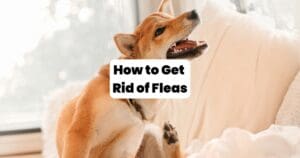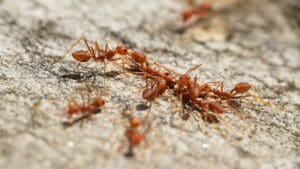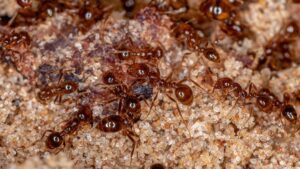Think you see swarming termites? Click here to learn how to identify termites or report a sighting on the termite swarm map. Think you have an infestation? Click here to get your next steps.
Owning a home in the southern states requires a lot of general upkeep and prevention that isn’t always necessary in the rest of the country. We are often required to purchase flood insurance as many homes are in flood zones, hurricanes and tropical storms mean we deal with roof damage more often, and last but not least, we deal with the increased risk of termite damage.
Regarding major risks for homeowners, termite infestation and damage are second to none. Where storms and flooding are covered by most homeowners’ insurance policies, termite damage is most likely not. Because of this, homeowners in the southern states need to maintain an active termite protection plan to prevent possible infestation and the risk of major structural damages.
Termite infestations present a major financial obstacle for homeowners. The financial damage caused by a termite infestation can be anywhere from $10,000 to $50,000 or more, depending on the severity of the infestation and the length of time it has gone untreated.
Table of Contents
What Are Termites?
In the simplest of terms, termites are one of the biggest enemies a homeowner can have. Right in line with burglars, fire damage, and storm damage, termites present a major financial risk to anyone who owns a home. But what about them makes them so destructive?
Termites, much like ants, live in large colonies that can reach populations in the millions. During termite swarming season, which typically runs from March until June or July, swarms can reach huge populations and are seen swarming in areas near homes by the thousands. Formosan termites which are most common in southern regions of the U.S. are most active during spring and early summer and will swarm during evening hours.
To understand termites and why they are such a threat to homeowners, you have to understand the anatomy of a termite colony and what they require to thrive.
The Anatomy of a Termite Colony
A typical termite colony consists of various roles, performing various jobs to ensure that the colony continues to grow, finding new homes, and spreading their reach. These include:
- Workers: Workers are some of the smallest termites in the colony, and are responsible for constructing the colony’s home and providing food for the colony and queen.
- Soldiers: Some of the largest termites in the colony, these “soldiers” are responsible for protecting the colony from predators and have distinctive jaws that separate them visually from the rest of the colony.
- Swarmers/Scouts: For simplicity’s sake, swarmers/scouts are termites that spawn wings and are responsible for seeking out new locations for colonies. They can be either male or female and are the termites you see swarming during the night looking for a new place to call home.
- The Queen: The Queen is the backbone of the colony. Like an ant colony, the queen is the largest termite in the colony and spends her entire day laying new eggs to continue to grow the colony in size.
The termite colony consists of many small members, making up one giant collective organism that works in unison to survive and thrive.
Characteristics of a Formosan Termite
There are several different species of termites across the world, but the most common and potentially one of the most destructive in the southern regions of the U.S. is the Formosan termite.
- Color: Yellow/Brown
- Size & Shape: Up to 1/2in, long/narrow oval-shaped body
- Features: 6 legs, antennae, and wings (shed during swarm season)
What is the Termite Swarming Season?
Termite swarming season occurs every year and can happen between spring and summer months. Depending on your area, the swarming season’s time frame will vary. Swarming season is referred to as such, as it’s the time of year when thousands of termites can be seen swarming any light source available during evening hours.
Why Do Termites Swarm?
Swarming season occurs as a result of termites looking to expand their colonies and find new homes. During this time frame, termites will send out scouts with wings to look for potential areas that would be ideal for a new colony. During this time, homeowners must keep an eye out for possible signs of an infestation. These signs include:
- Termites swarming nearby or close to your home (around exterior lighting, etc)
- Mud tubes around the foundation of your home (or inside of it’s structure)
- Damaged wood around your property or home
During this time, it’s important to keep an eye out for these signs, as most infestations go completely unnoticed until the damage has already been done.
How to Prevent Termite Infestation
The most crucial step to preventing damage to your home is to protect your home from becoming infested. There are many different ways that this can be done, but you can take several steps to help ensure that your home is a less-than-ideal home for a new colony of termites.
Eliminate Potential Termite Food Sources
Everyone knows that termites feed off the wooden structures in and around our homes. What many people neglect are the sources of non-living wood that may be attracting termites.
- Remove rotting stumps, logs, or tree limbs around your property
- Get rid of stacked firewood or rotting landscape timber
- Avoid using wood mulch in gardens or areas close to your foundation
Reduce High Moisture Areas
For a termite colony to survive they need a source of water. The moisture in and around your home can help create an ideal environment for a termite colony, so eliminating any source of moisture is essential in preventing termites.
- Divert water away from the home with gutters and downspouts
- Eliminate leaking plumbing
- Ensure that crawl spaces and attics have adequate ventilation
Trim Heavy Brush & Vegetation
Heavy vegetation growth near your home helps to create a moist environment and can act as a source of moisture for a termite colony. Clear heavy brush and vegetation from around your home, cut back bushes, and clean garden areas regularly.
Perform Routine Home Inspections
While it is always a good idea to have a professional home inspection done and routine treatments performed, you can perform certain inspections of your home to let you know whether or not your home is infested.
Inspect the exterior of your home, looking around the foundation and near light or water sources for:
- Mud tubes leading into or around the home
- Discarded wings from swarming termites
- Damaged interior or exterior wood surfaces
- Droppings from termites (look like tiny brown pebbles)
Have Your Home Inspected by a Termite Control Company
While there are many simple steps that you can take to help prevent a termite infestation, the best method of prevention is to have your home professionally inspected and if needed, treated by a termite control company. Professionals are trained to find the telltale signs of a termite infestation and have the tools and treatments necessary to ensure that your home is protected.
To truly protect your home from termite infestation requires professional inspection and treatment. If you think your home may have termites or want professional protection, contact Arrow Termite & Pest Control today.
Signs of a Termite Infestation in Your Home
One of the dangers homeowners need to be concerned with is Termites, as they can cause tremendous damage both inside and outside of the home. According to Realtor.com, termites are considered the biggest threat to wood-based structures, ahead of both fires and flooding.
Fortunately, termite damage is preventable; it’s simply a matter of knowing what to look for, properly preparing your home, and making sure your home has been professionally inspected/treated by a termite control company.
To properly protect your home, you have to know how to prepare your property and what to look for to identify a termite problem.

Groups of Winged Insects or Discarded Wings
When termite season begins, swarms of termites take to the skies in search of places to build their colonies. Once they’ve found a suitable location, they will settle in and begin building, leaving behind their wings in the process. When inspecting your property, keep an eye out for the discarded wings of termites; this is a telltale sign that there may already be a colony of termites nearby.
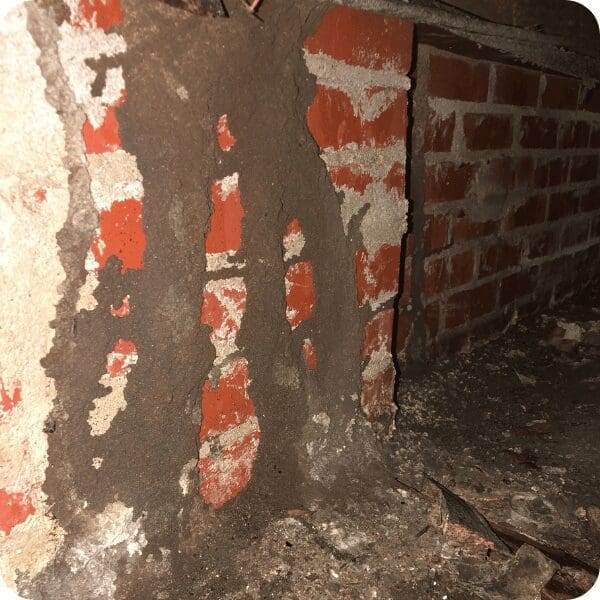
Mud Tubes on Walls or Structures
When subterranean termites build their colonies, they create mud tubes (or shelter tubes) as they move from the ground into structures and homes. Their mud tubes can appear in corners and joints between surfaces and allow the termites to travel throughout their growing colonies. If you notice abnormal buildups or mud/dirt in abnormal places, it may be a sign that termites have made their way into your home. When inspecting the inside of the home, take a look at your drywall and along baseboards in the home.

Damaged or hollow-sounding Wood
While the wooden structure in the home may appear to be in good condition visually, on the opposite side there may be damage hiding. As termites prefer to be in dark, damp places, they very rarely let their work be visible inside of your home. Simply tapping on surfaces and listening for a hollow sound can be a good indicator that termite damage may be present. Wood and surfaces without damage should produce a solid sound, wood that has termite damage may produce a more hollow sound depending on the extent of the damage.

Bubbling or Cracked Paint on Walls or Ceilings
Should you notice any bubbling or flaking of paint, or “honeycombing” on baseboards, this may be a sign of a termite problem. Internal damage on drywall and ceilings can often resemble minor water damage and can often be overlooked.
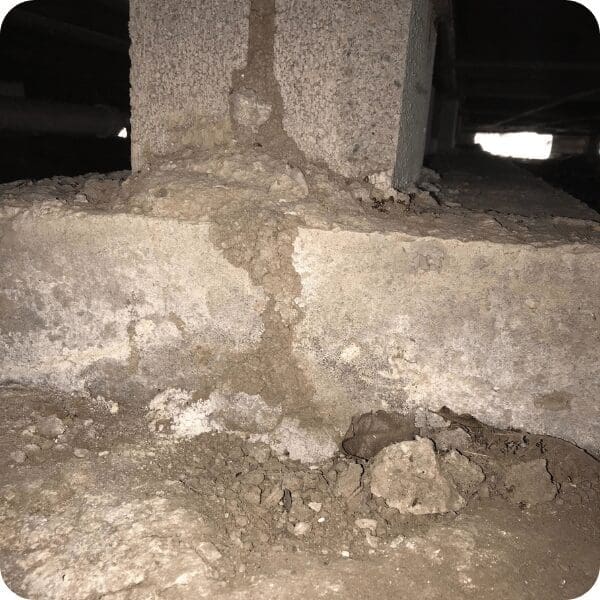

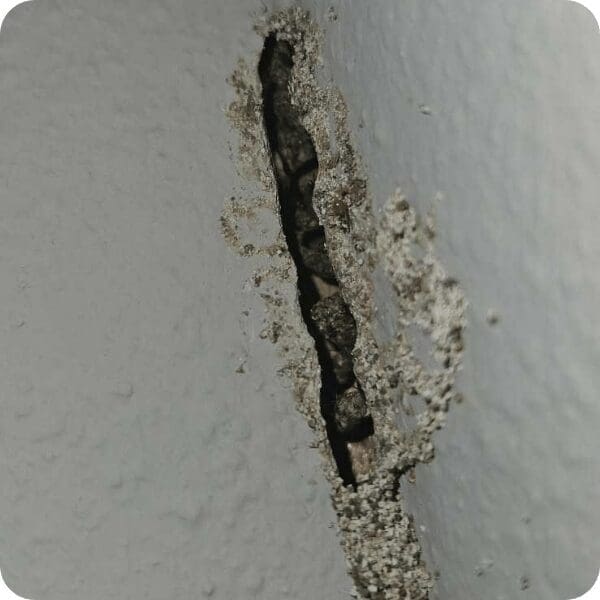
As always, the best way to know for sure is to have your home professionally inspected. Arrow Termite & Pest Control has the skills and technology necessary to properly assess your home for termite damage and can help provide you with protection and peace of mind.
Termites Are Swarming, What Should I Do?
As termite season approaches, it’s crucial to stay proactive in protecting your home from these destructive pests. At Arrow Pest Control, we understand the challenges homeowners face with Formosan termites, especially during their swarming period in May and June. Our customer service representatives are here to offer effective solutions and peace of mind.
Termite swarmers, or alates, are winged Formosan subterranean termites that emerge from their nests to form new colonies, most commonly in spring. They swarm around dusk and are attracted to light sources. To minimize swarmers inside the home, turn off your interior lights and turn on a competing light source away from the home.
Swarmers indicate the presence of a colony nearby like in old tree stumps or areas where wood is in direct contact with soil. These swarmers pair up, mate, and commence the search for a suitable nesting site. Be especially alert for swarms of Formosan termites from May to June, with their highest activity around Mother’s Day.
- If you have a termite contract, your annual renewal keeps your property protected from termite infestations but does not guarantee you won’t see termites swarming during swarm season.
- Take the time to read your termite contract. If you’d like to request an updated copy, please contact our support team.
- Be aware of our termite claims process. If you see 50-100 termites in your home and believe you may have an infestation, reach out to customer service and we’ll provide you with the information you need.
Differences Between Termites and Ants:
Termites are often confused with flying ants. While they certainly look similar, it’s fairly easy to tell them apart if you know what to look for.
- Termites have straight antennae, while ants have angled
- Termites have a robust mid-section, while ants have a very narrow waistline.
- Termites wings are equal in length, while ants front wings are longer than the rear wings
- Termite workers are transparent/white/light in color, while ant workers are dark brown, black or reddish

What to Look For During The Swarm:
- Discarded wings around windowsills and doors.
- Mud tubes or tunnels.
- Pin holes, rippling in sheetrock or wood framing soft to touchs
I Think I Have a Termite Infestation, Now What?
For Arrow customers, there is a process we follow to address the termite issues efficiently and effectively. Your termite control company likely has a similar process in place. Please review and follow the important information below if you suspect you have a termite infestation.
- The first step is for Arrow to inspect the structure and treat any infestation of live termites.
- Do not treat anything yourself or have another company treat it. This will void the warranty and can make Arrow’s job much harder to control the termites. PLEASE TAKE TIME TO READ YOUR CONTRACT. YOU MAY REQUEST AN ADDITIONAL CONTRACT COPY OR UPDATED COPY.
- Most termite contracts include all treatment on structures under contract. If you have a Liquid Soil Contract your liquid soil treatment is covered by the terms of your contract. If you have a Baiting Treatment Contract, baiting treatment is covered by the terms or your contract. Your regular renewal fee covers the additional trips and treatments needed within the contract stipulations. Some contracts and structures, if qualified, have a limited damage warranty that cover termite damages according to terms and conditions.
- What damage is not covered: structures with treatment only contracts (no damage warranty), structures with moisture issues related to the termite infestation/damage, structures with aerial infestations of termites, structures that have undisclosed breaks in the barrier, infestations that emanate with cracks in the foundation, houses with construction defects/not built to code, and areas where new concrete has been poured and Arrow was not notified. If a lapse has occurred in your agreement, you have a retreat only warranty unless damages are reapproved in writing by an Arrow Rep. See Contract.
- If wall areas are torn out to address structural damage, it is the responsibility of the homeowner to call Arrow before any wall coverings are replaced so Arrow can inspect and treat affected areas accordingly. If wall areas are torn out for “exploratory reasons” when there is only cosmetic damage, Arrow will not be responsible for the additional repairs needed if walls are opened up and structural damage is not present.
- If termite damages are agreed to be paid by Arrow per the contract, Arrow will utilize a contractor of their approval. If you have your own contractor, Arrow must approve them as being qualified to repair termite damage and they must be licensed, bonded, and insured. They must submit quotes for all work in writing and Arrow must approve all work in writing before any payments can be made. Arrow will use the lowest responsible price of a qualified contractor. Do not have any contractor perform work unless the home is inspected first by Arrow and a repair quote is approved in writing by Arrow. Arrow can make no guarantee that we will openly pay any invoice without first getting quotes and approval by Arrow in writing.
- The Timeline: Termites can be difficult. Most termite colonies will be eliminated fully with treatment within 60-90 days of re-treatment per product manufacturer standards. Many damages that occur are caught early without compromising the integrity of the structure. Most decisions concerning termite damage compensation and liability will be made within 30-90 days after full investigation, quotes, approvals, etc.
Common Circumstances That Void a Termite Damage Warranty’s Coverage
- Stucco to ground contract or wood to ground contact: This includes but is not limited to stucco columns, unremoved wooden form boards, or piers in direct contact with the ground. Any column that is built directly over a construction joint will not be covered because Arrow cannot properly inspect it and may contain possible hidden damage.
- Undisclosed Joints: All interior concrete joints must be disclosed to Arrow so we may inspect and treat the interior properly. Termites commonly come up interior joints.
- Disturbance of the treatment barrier or stations: Any disturbance/addition of dirt, rocks or fill within 1 foot of the slab may alter the termite barrier and its effectiveness. Any baiting station removed/disturbed must be reported immediately to Arrow. A certified technician needs to inspect and/or treat the disturbed area(s).
- Lapse(s): If you have a damage warranty and a lapse in the contract, your policy will no longer cover damages. Please contact our office to schedule an assessment of your property. Our office will schedule an appointment with one of our certified inspectors to re-qualify your home with a FREE INSPECTION. A lapse only occurs if your payment is not processed by the contract renewal date; not the service or inspection.
- Signing a Waiver: Arrow must treat all areas according to the minimum specifications of our regulatory agency and label requirements. If you have termite damage in a waived area, only treatment will be covered and not termite damages.
- Old Damage: Old damage may only be covered if there has never been a lapse in the Arrow termite contract.
- Moisture Conditions and Improper Home Maintenance:
- Termite infestations surrounding and related to leaks, mold, mildew, brown rot and white rot.
- Leaking balconies, wooden windows, bathrooms, leaking and rotted gutter systems.
- Sprinkler systems that routinely spray on wooden windows, cracked stucco or uncaulked siding.
- Areas where moisture/mold/mildew problems exist will not be covered by Arrow.
- Spray Foam Insulation: Any area with spray foam insulation present voids the damage warranty on the termite contract. Spray foam insulation obstructs termite inspections and treatment, especially around wood structure areas, where termites are commonly found. In the event your home has spray foam insulation and a termite infestation, Arrow will only be responsible for the treatment of the infestation. Damages will not be paid.



